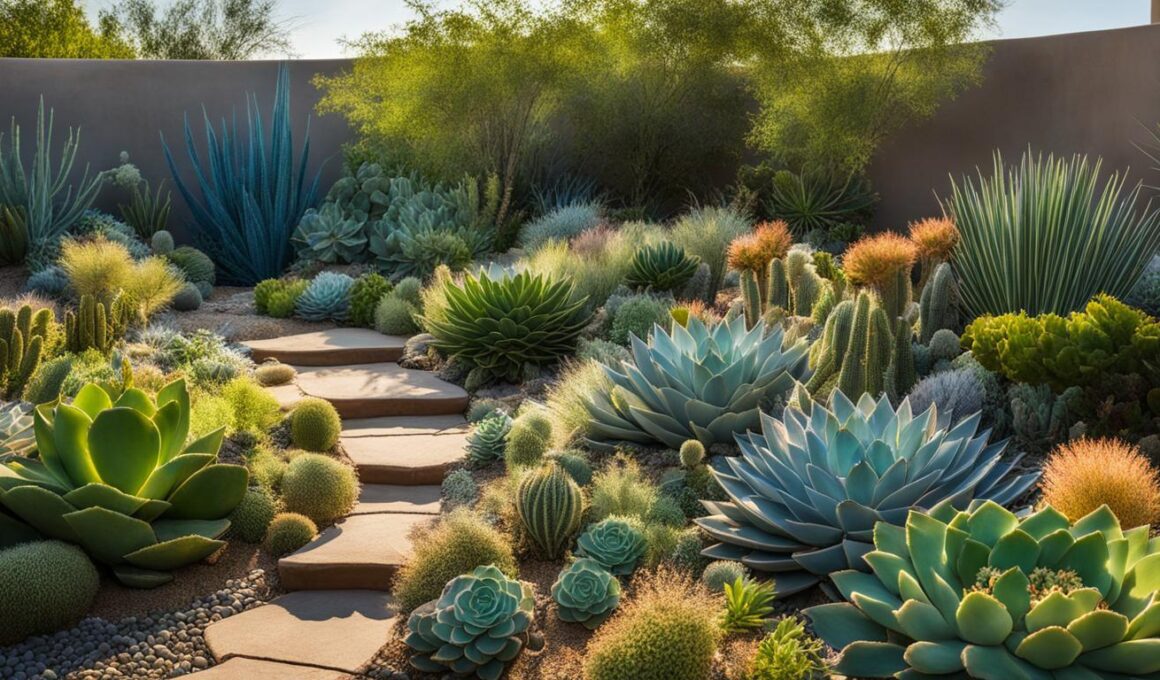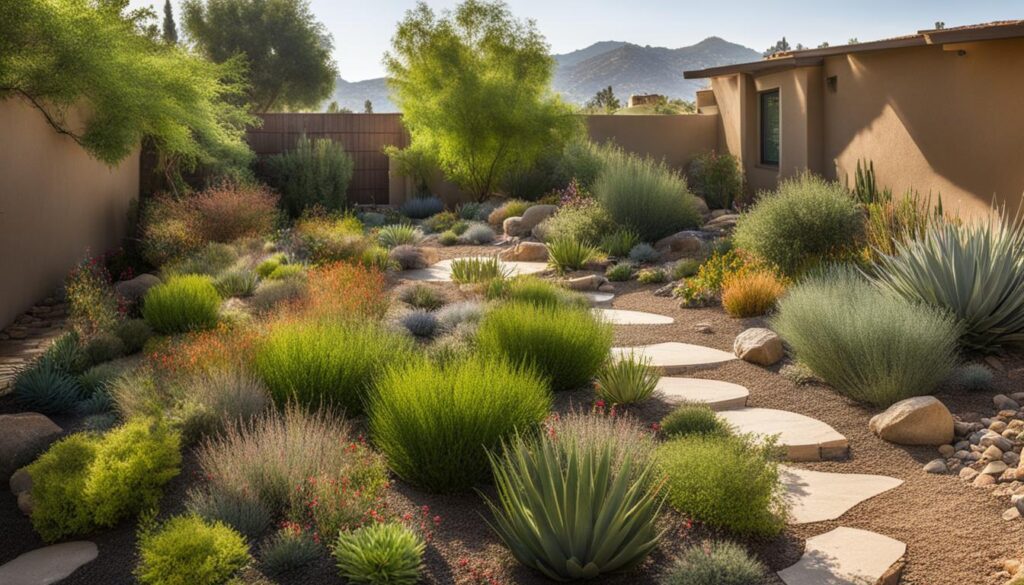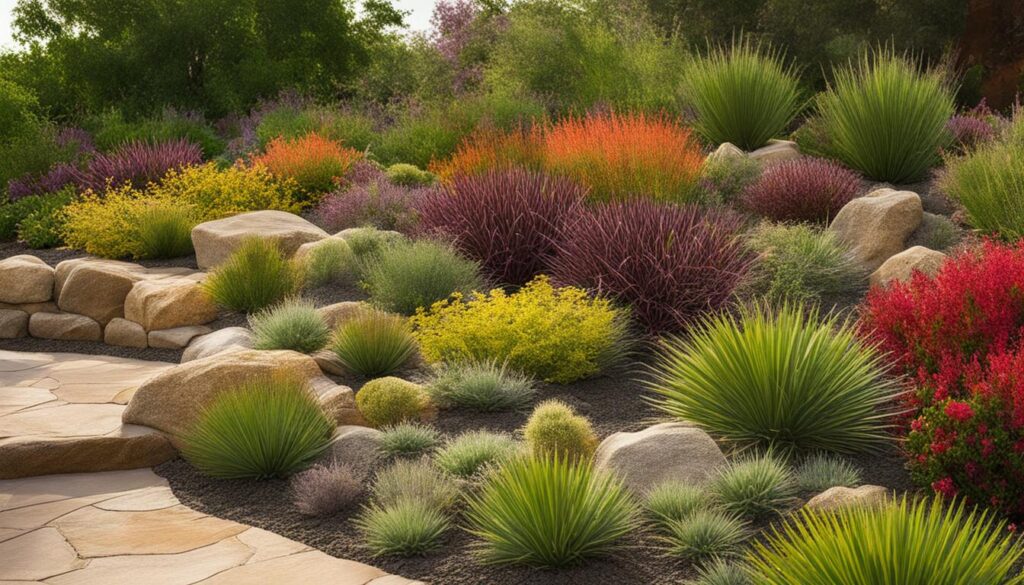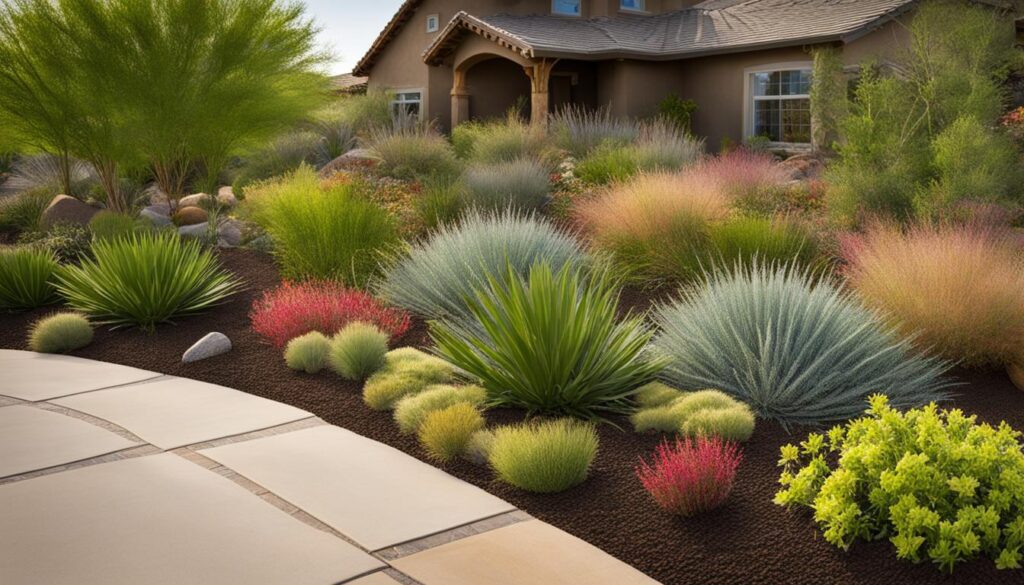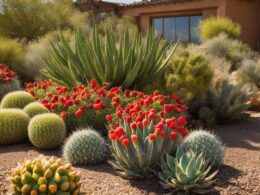Xeriscaping, also known as climate-appropriate planting, is a landscaping technique that conserves water and protects the environment. It is a popular method for managing water scarcity in many US states, such as California. Contrary to common misconceptions, xeriscaping does not limit garden design to desert plants. With the right selection of climate-appropriate plants, you can create a lush and beautiful garden while minimizing water consumption.
This article will provide a list of 10 climate-appropriate plants that are suitable for xeriscaping.
Key Takeaways:
- Choose climate-appropriate plants for xeriscaping to create a beautiful garden while saving water.
- Xeriscaping offers benefits such as reduced water usage and lower costs on water bills.
- Xeriscape gardens require less maintenance and intervention, making them ideal for busy homeowners.
- Follow the principles of xeriscaping to design a sustainable landscape that conserves water.
- With the right selection of climate-appropriate plants, you can create a resilient and water-saving landscape.
Benefits of Xeriscaping: Reduce Water Usage and Lower Costs
Xeriscaping offers several benefits for both the environment and homeowners. By choosing drought-tolerant plants, you can significantly reduce your water usage and contribute to water conservation efforts. These climate-appropriate plants are well adapted to arid conditions and require less irrigation compared to traditional garden plants. As a result, xeriscaping can help you save hundreds of gallons of water each year, making it an eco-friendly choice.
Another advantage of xeriscaping is the potential for lower costs. With traditional gardens, watering can account for a significant portion of monthly water bills. By embracing xeriscaping, you can eliminate the need for frequent watering and reduce your water consumption. This can lead to substantial savings on your water bills over time. Additionally, xeriscape gardens are designed to be low maintenance, requiring less time, effort, and resources for upkeep. This makes it an attractive option for homeowners with busy schedules.
“Xeriscaping is not only about saving water, it’s also about creating sustainable landscapes that are visually appealing and resilient.” – Landscaping expert
By implementing xeriscaping techniques and selecting climate-appropriate plants, you can create a beautiful and sustainable landscape that enhances the aesthetic appeal of your outdoor space. Xeriscape gardens are known for their ability to thrive in challenging conditions, such as drought and limited water availability. With the right choice of plants, you can enjoy a lush and vibrant garden while reducing your environmental footprint. So why not embrace xeriscaping and reap the benefits of reduced water usage, lower costs, and a stunning garden?
The Key Benefits of Xeriscaping:
- Significantly reduces water usage
- Contributes to water conservation efforts
- Eliminates the need for frequent watering
- Leads to cost savings on water bills
- Requires less maintenance and intervention
- Creates visually appealing and sustainable landscapes
Top 10 Climate-Appropriate Plants for Xeriscaping
If you’re looking to transform your garden into a beautiful and water-efficient space, xeriscaping is the way to go. By selecting the right climate-appropriate plants, you can create a lush and vibrant landscape while reducing water consumption. Here are the top 10 climate-appropriate plants that are perfect for xeriscaping:
- Lavender – Known for its aromatic fragrance and stunning purple flowers, lavender is a drought-tolerant plant that thrives in full sunlight. It adds a touch of elegance to any garden.
- Agave – With its striking architectural form and ability to withstand dry conditions, agave is an excellent choice for xeriscaping. It requires minimal watering and adds a unique focal point to your garden.
- Yucca – This versatile plant is known for its sword-like leaves and beautiful white flowers. Yucca is highly drought-tolerant and can thrive in a wide range of soil conditions.
- Red Hot Poker – Also known as Kniphofia, this plant boasts vibrant orange and red flower spikes that attract pollinators like hummingbirds. It is well-suited for dry climates and adds a pop of color to your garden.
- Salvia – Salvia, also known as sage, is a popular choice for xeriscaping due to its tolerance for heat and dryness. It comes in a variety of colors, including purple, red, and white.
- Cacti – Cacti are iconic desert plants that require very little water. With their unique shapes and textures, they add a touch of intrigue to any xeriscape garden.
- Ornamental Grasses – Ornamental grasses, such as feather grass and blue fescue, not only tolerate dry conditions but also provide movement and texture to your garden.
- Black-Eyed Susan – This cheerful flower blooms with bright yellow petals and a dark center, attracting butterflies and other pollinators. It is a hardy plant that thrives in dry conditions.
- Sedum – Sedums are low-growing succulents that come in a variety of shapes, sizes, and colors. They are hardy plants that require little water and provide year-round interest.
- California Poppy – The California poppy is a drought-tolerant wildflower that produces beautiful orange and yellow blooms. It is well-suited for xeriscapes and adds a touch of natural beauty to your garden.
By incorporating these climate-appropriate plants into your xeriscape garden, you can create a sustainable and visually appealing outdoor space that thrives in dry conditions. Remember to consider factors such as soil type, sunlight exposure, and water requirements when selecting plants for your xeriscape garden.
Principles of Xeriscaping: Designing a Sustainable Landscape
Designing a sustainable landscape through xeriscaping involves following a set of principles that promote efficient water usage and environmental preservation. By incorporating these principles into your garden design, you can create a beautiful and resilient landscape that thrives in arid conditions while reducing water consumption.
1. Soil Improvement:
The first principle of xeriscaping is to improve the soil’s ability to retain water. By adding organic matter, such as compost or well-rotted manure, to the soil, you can enhance its water-holding capacity. This allows plants to access moisture more effectively, reducing the need for frequent watering.
2. Water-Efficient Plant Selection:
Choosing plants that are naturally adapted to your region’s climate is crucial for a successful xeriscape garden. Opt for drought-tolerant plants that can withstand long periods without water. Native species are often a great choice as they have evolved to thrive in local conditions and require minimal irrigation.
3. Efficient Irrigation:
Xeriscaping encourages the use of efficient irrigation methods to minimize water waste. Drip irrigation systems, for example, deliver water directly to the plant’s root zone, ensuring maximum water efficiency. Grouping plants with similar water needs together can also help optimize watering practices.
“Xeriscaping involves following a set of principles that promote efficient water usage and environmental preservation.”
4. Mulching:
Mulching is an essential component of xeriscaping. Adding a layer of organic mulch, such as bark chips, straw, or compost, around plants helps retain moisture in the soil, suppresses weed growth, and moderates soil temperature. Mulching also helps prevent soil erosion, ensuring that water is not wasted through runoff.
By embracing these principles of xeriscaping, you can design a sustainable landscape that not only conserves water but also adds beauty and value to your outdoor space. Incorporate climate-appropriate plants into your garden and follow these guidelines to create a vibrant and eco-friendly landscape that will thrive even in water-scarce environments.
Conclusion: Create a Beautiful Xeriscape Garden with Climate-Appropriate Plants
With the increasing importance of water conservation, xeriscaping has become a popular choice for creating resilient and water-saving landscapes. By choosing climate-appropriate plants, you can transform your garden into a lush and vibrant space while significantly reducing water usage.
The list of 10 climate-appropriate plants provided in this article offers a variety of options to suit different preferences and garden styles. Whether you prefer colorful flowers, textured foliage, or ornamental grasses, there’s a plant on this list that will add beauty and sustainability to your xeriscape garden.
By following the principles of xeriscaping, you can design a sustainable landscape that not only conserves water but also enhances the beauty of your outdoor space. With proper planning and maintenance, your xeriscape garden will thrive, requiring less water, time, and effort compared to traditional gardens. So, get started and unleash your creativity to create a beautiful xeriscape garden that will be the envy of your neighbors.





